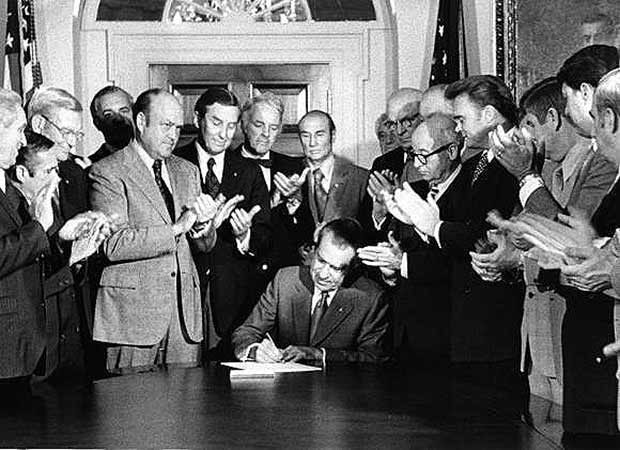Bankers, investors, and gold dealers alike particularly enjoyed the dramatic increase in the 1 oz gold price since the Nixon Shock of the early 1970s. Nixon decided to remove the direct exchange of US greenbacks to gold.
In so doing he effectively eliminated gold as the centrepiece of global currency evaluation. Answering should we go back to the gold standard requires a brief look at the history. So what took the place of gold? Well, a floating exchange rate system did. In this system, national currencies gained their value relative to each other.
Despite certain speculative risks, this is the system we rely on today. It is also a departure of the highest proportions from historic monetary systems. As noted, these relied on a fixed price of gold to keep currency devaluations in check.
Under the gold standard, global currencies had to respect a fixed exchange rate such as USD $35 per oz. of gold. Back then, the amount of gold a currency could buy determined the value of their currency.
Do Floating Currency Systems Work?
In the floating system there are a number of risks. Economic wizard Paul Krugman writes that the Federal Reserve can “print as much or as little money as it deems appropriate.” Sounds pretty dangerous, right? It sure does to Mr. Krugman, who has noted how volatile the dollar has been since the move away from the gold standard.
The floating system works in much the same way as the free market. When supply and demand create bubbles in exchange rate, governments simply print more money to prevent stagnation. This is exactly what happened with the USD.
The USD Became Stronger in the Short-Term
Nixon’s bold move proved to be beneficial for the greenback in the short-term. The value of USD dropped a third in the early 1970s and forced other currencies to rise in value, thus creating a more stable global marketplace for international trade.
But this did not last long. The Federal Reserve kept pumping out money to keep the currencies relatively equal, and in doing so, produced grave inflationary pressures that have not gone away. The USD has fluctuated in value so much that it makes investors skeptical and can actually prevent growth. So in the long-run it’s not clear that floating currency evaluation is any better for the global economy.
The perplexing question is that should we go back to the gold standard, it may not be so good for gold’s long-term value. In fact, unless we went through an economic crisis, it would probably be terrible.
The Gold Standard Would Drop the Price of 1 oz. of Gold
When the USD becomes incredibly volatile, the price of gold goes on a rampage. Should we go back to the gold standard, this would not happen. We would no longer see floating rates, and instead a fixed rate per oz. A real challenge is that the floating system allows gold flexibility in the currency, investment and commodities markets.
Check out the increase in gold from 1971-74:
1 oz. gold price in 1971: gold cost USD $44.60.
1 oz. gold price in 1972: gold cost USD $63.84
1 oz. gold price in 1973: gold cost USD $106.48
1 oz. gold price in 1974: gold cost USD $183.77
And after all that, the price of gold peaked in 1979 and has been on a slow upward climb since 2003.
So Nixon did a world of good for the gold bullion suppliers and investors in concluding the gold standard. If the gold standard was brought back, gold would lose a lot of its appeal as an investment vehicle almost overnight.
Another issue is that all countries need to be on the same page. Otherwise, it would be far too lucrative to buy gold from one nation and sell it for floating currency of another. Only if gold were given a set value at which all other currencies could bought and sold could you mitigate incentives to trade at a nation’s expense.
Should we go back to the gold standard now? Even if it might be bad for gold, can we?
The funny thing is that floating exchange rate systems are good for gold. By inherently devaluing currency over time, they make gold attractive as both a hedge and investment. By putting inflationary pressure on the dollar, floating exchange rates spur gold prices.
As you know, the price per 1 oz of gold rises when currencies are particularly unstable. Meera Shawn at Market Realist reflects on how this has to do with general economic health as reflect in gross domestic product (GDP) numbers.
So to answer the initial question, “should we go back to the gold standard?” maybe not? Having spoken of currencies, one often neglected is that of political currency. There is clearly little in the way of political currency or capital to bring back the gold standard. So should we not return to the gold standard? Well, bringing it back would require effectively destroy the gold commodities market.
While it might prop the entire global economy back on the shoulders of the United States, it might just as well pop the US economy into a severe depression. With that in mind, reducing national debt and getting our economy back on track may be a safer place to start.

